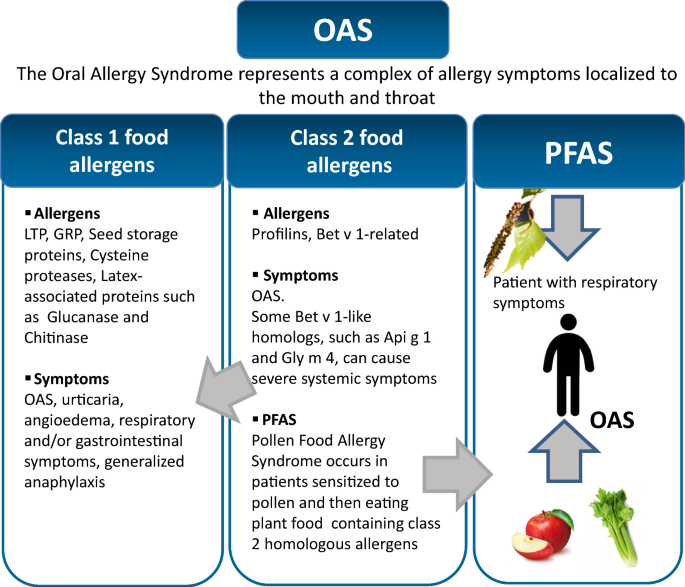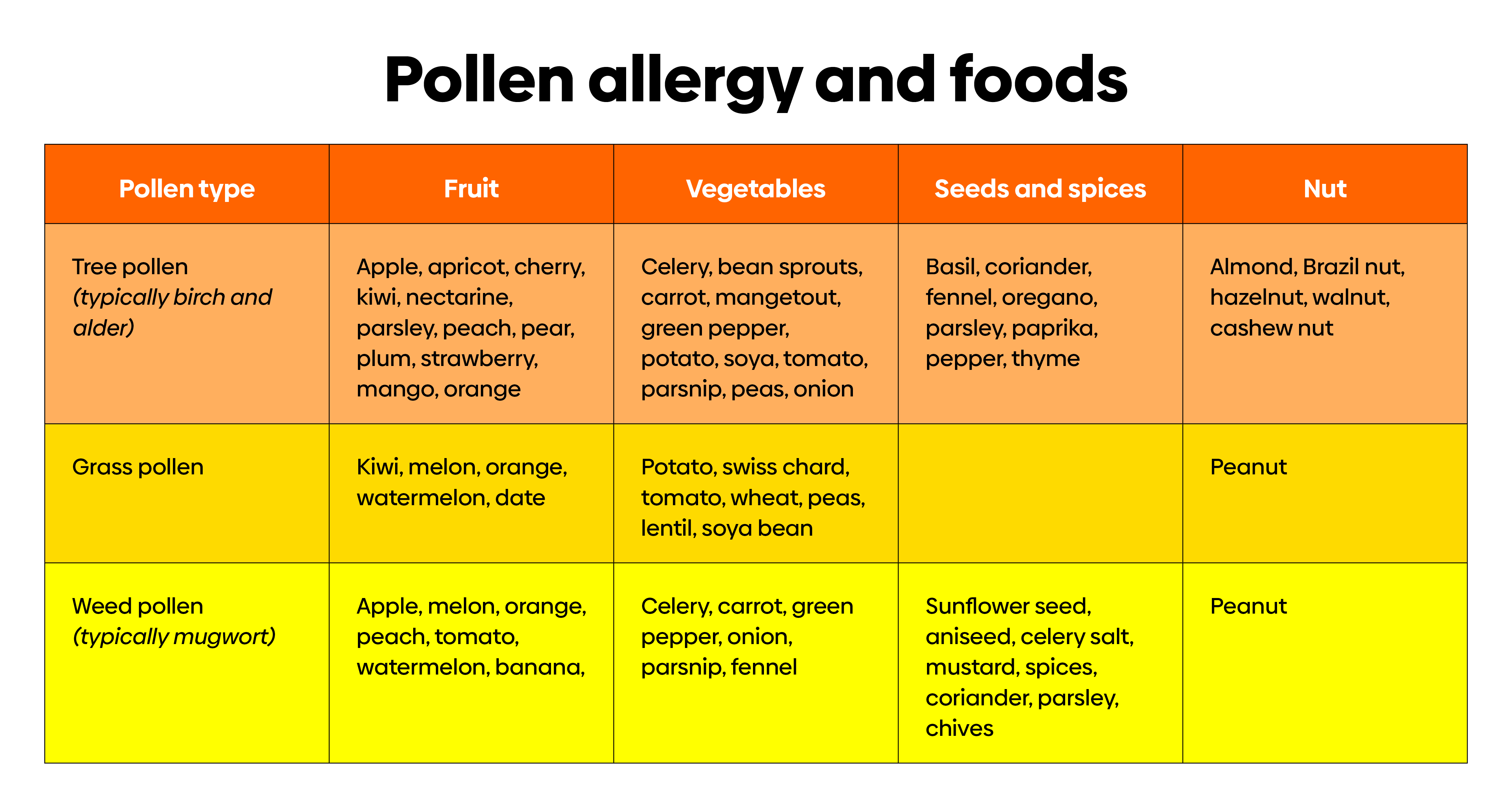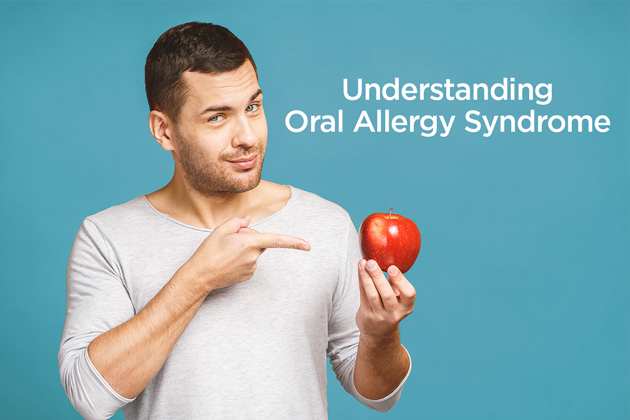“The Complete Guide to Oral Allergy Syndrome: Understanding, Managing, and Living with OAS”
Oral Allergy Syndrome (OAS), also known as pollen-food syndrome, is a condition that affects many individuals who suffer from pollen allergies. It’s important to grasp the concept of OAS as it can significantly impact your daily life and dietary choices. Let’s delve into this condition to better understand it.
Causes of OAS

OAS is primarily caused by cross-reactivity between certain proteins found in pollen and various fruits, vegetables, and nuts. When someone with pollen allergies consumes these trigger foods, their immune system may recognize the proteins as allergens and trigger an allergic response.
Common Triggers

The most common OAS triggers include apples, pears, peaches, and almonds. These foods share structural similarities with pollen proteins, leading to the body’s immune system confusing them with the allergens they’re already sensitive to.
Cross-reactivity with Pollen
Understanding the connection between OAS and pollen is essential. Different pollens are associated with specific trigger foods. For instance, birch pollen allergies can lead to reactions with apples, while ragweed pollen allergies may result in responses to melons.
Symptoms of OAS

Symptoms of Oral Allergy Syndrome can vary in severity and may include itching, swelling, and tingling in the mouth, throat, or lips. In more severe cases, it can lead to hives, stomach discomfort, or even anaphylaxis.
Diagnosis and Testing
If you suspect you have OAS, consult an allergist who can diagnose the condition through skin prick or blood tests. Identifying the specific trigger foods is essential for managing the condition effectively.
Coping with OAS
Coping with OAS primarily involves avoiding trigger foods. However, there are cooking methods that can reduce the allergenicity of certain foods, making them safer to consume for those with OAS.
Managing Allergies with Diet
While OAS may limit your dietary choices, there are ways to adapt. Understanding which foods to avoid and finding safe alternatives is crucial for maintaining a balanced diet.
The Connection to Seasonal Allergies
OAS often goes hand in hand with seasonal allergies. Pollen in the air can exacerbate symptoms, making it important to understand the link between the two.
read more about Decoding SAD: Understanding Seasonal Affective Disorder
Cross-reactivity Chart

The cross-reactivity chart is a valuable tool designed to simplify this complex relationship. It highlights common allergenic foods and their corresponding pollen counterparts. This chart acts as a reference guide, aiding those who are managing OAS in making informed dietary choices.
Here’s how the cross-reactivity chart works:
- Common Allergenic Foods: This section of the chart lists various foods that are known to trigger OAS in susceptible individuals. Examples include apples, peaches, and almonds, among others.
- Corresponding Pollen Counterparts: For each allergenic food, the chart identifies the specific pollen type with which it cross-reacts. For instance, birch pollen often cross-reacts with apples, while ragweed pollen can trigger reactions with melons.
The chart serves as a quick reference for individuals with OAS, helping them identify potential trigger foods based on their pollen allergies. By understanding these cross-reactivity patterns, those with OAS can make more informed dietary choices, reduce the risk of allergic reactions, and better manage their condition.
OAS vs. Traditional Food Allergies
Distinguishing between OAS and traditional food allergies is essential. OAS typically manifests as mild and localized symptoms, whereas traditional food allergies can lead to more severe, systemic reactions.
Prevention
Preventing OAS involves understanding your specific triggers and taking steps to minimize exposure. This section provides strategies to reduce the risk of developing OAS.
Treatment Options
In the event of OAS symptoms, various treatment options are available, including medications and immunotherapy, to help manage the condition effectively.
Lifestyle Adjustments
Adapting to life with OAS may require some lifestyle adjustments. This section offers guidance on how to integrate OAS management into your daily routine.
Research and Advancements
Stay up-to-date with current developments in OAS studies and research. New advancements may provide insights into improved management and treatment options.
Conclusion
In conclusion, Oral Allergy Syndrome is a unique condition that affects individuals with pollen allergies. Understanding its causes, symptoms, and management strategies is essential for those dealing with OAS. By staying informed and taking the necessary precautions, you can lead a healthier and more comfortable life despite this condition.
Frequently Asked Questions
- Can OAS develop in adults, or is it something you’re born with? OAS can develop at any age, even in adulthood. It’s not exclusive to childhood or something you’re born with.
- Are there any foods that can help alleviate OAS symptoms? While there’s no cure for OAS, some foods can be less allergenic and may cause milder reactions. It’s essential to work with an allergist to identify safe food options.
- Can OAS be a lifelong condition, or do symptoms improve over time? OAS symptoms can vary from person to person. Some may experience improvement over time, while others may continue to have sensitivities throughout their lives.
- What are the primary differences between OAS and traditional food allergies? OAS typically causes mild and localized symptoms, mainly affecting the mouth and throat, while traditional food allergies can result in more severe and systemic reactions.
- Is it safe for individuals with OAS to consume cooked versions of trigger foods? Cooking certain trigger foods can reduce their allergenicity for some individuals with OAS. However, it’s essential to consult with a healthcare professional before attempting this.







 Viesearch - The Human-curated Search Engine
Viesearch - The Human-curated Search Engine
